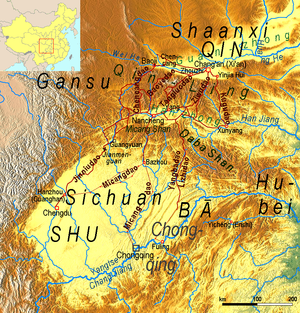Stone Cattle Road
This article needs additional citations for verification. (May 2023) |
The Stone Cattle Road (
in 316 BC.
Story
The story goes that King
Qinling Mountains
over the Tianshaling and Wuting passes. Legend says it was built to seize oxen of a similar nature that lived in the mountains.
History
In order to reach Sichuan from Qin one must travel south over the difficult Qinling Mountains to the
Han River basin and then southwest over the Daba Mountains to the Sichuan Basin. Naturally there were footpaths, but sending an army, and the later extraction of tribute, required a road suitable for wheeled vehicles. For the more difficult sections a gallery road had to be constructed. Horizontal holes were bored into the rock and logs inserted in them. Where possible, vertical logs were placed to support the outer ends and the whole was covered with planks. (In 1979 Chinese archeologists located 56 horizontal holes and 190 vertical holes in 22 different locations.) If the Qin invasion of 316BC was a sudden decision provoked by the Marquis of Zu's quarrel with the King of Shu then the road, or part of it, must have been in place before this. The more difficult northern part was in Qin territory, the southern part in Shu and the middle part in Ba, although the exact boundaries are not clear. Most of the expense and engineering must have come from Qin. Given that the distance from the Wei valley to Chengdu
is about 500 kilometers, it is unlikely that the whole road was built at once.
Sage remarks that "determining the Qinling portion of the route was once one of those perennial quibbles like the attempts to find Hannibal's path through the Alps." His view is that the Qinling portion corresponds to the Baoxie Plank Road. This ran from southeast of the Qin capital of
Liu Bang
used for his initial breakout of the Han valley. This probably corresponds to the modern S210 highway. After the conquest there was a 'Rice Granary Road' that went south from Hanzhong and then swung west. As Sichuan became more developed there were other roads of greater or lesser importance.
Notes
References
- ISBN 978-0-00-722178-3
- Stephen F. Sage, Ancient Sichuan and the Unification of China, 1992
